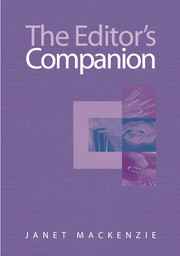Book contents
- Frontmatter
- Contents
- List of illustrations
- Preface
- 1 The editor in context
- 2 The publishing process
- 3 Management and liaison
- 4 Substance and structure
- 5 Language
- 6 Illustrations and tables
- 7 Completeness and consistency
- 8 Proofs
- 9 Editing methods
- 10 Working with documents and files
- 11 Freelance editing
- Appendix: Australian Standards for Editing Practice
- Notes
- Select bibliography
- Index
- Frontmatter
- Contents
- List of illustrations
- Preface
- 1 The editor in context
- 2 The publishing process
- 3 Management and liaison
- 4 Substance and structure
- 5 Language
- 6 Illustrations and tables
- 7 Completeness and consistency
- 8 Proofs
- 9 Editing methods
- 10 Working with documents and files
- 11 Freelance editing
- Appendix: Australian Standards for Editing Practice
- Notes
- Select bibliography
- Index
Summary
Language creates and controls the world: the act of naming brings concepts into existence and imposes order on chaos. Modern English is an amazing artefact, the product of thousands of years of collaborative human effort, a communication tool that is protean, subtle, sophisticated.
English is capable of great precision because its vocabulary is rich in near-synonyms. It also has great flexibility in two dimensions. First, it relies on word order rather than inflections–an upset win is the opposite of a set-up win, and the difference between good-looking and looking good is about twenty years. Second, its parts of speech are largely interchangeable–for instance, out may be an adverb, a preposition, a noun or a verb. English is also succinct, as textbook publishers have found to their cost when trying to fit translations into a tight page grid.
All living languages exist in a state of tension between growth and decay. Languages change because playfulness and the desire to impress are universal human traits; they grow in response to technological innovation, cultural contact and social developments. Working against these impulses to the new are the forces of stability: inertia, the fear of being misunderstood, and the fixative effect of writing.
Chapter 9 gives examples of language editing: here we look at the principles.
Clarity and precision
A sure command of the English language is one of the core skills of editing, along with general knowledge and an understanding of typography.
- Type
- Chapter
- Information
- The Editor's Companion , pp. 75 - 94Publisher: Cambridge University PressPrint publication year: 2004



